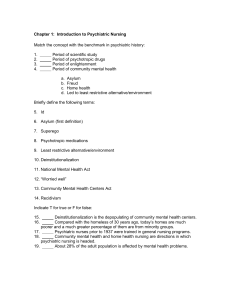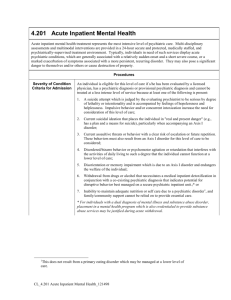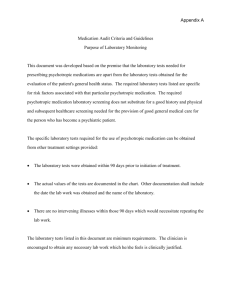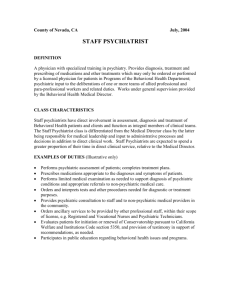article - Ontario Association on developmental disabilities
advertisement
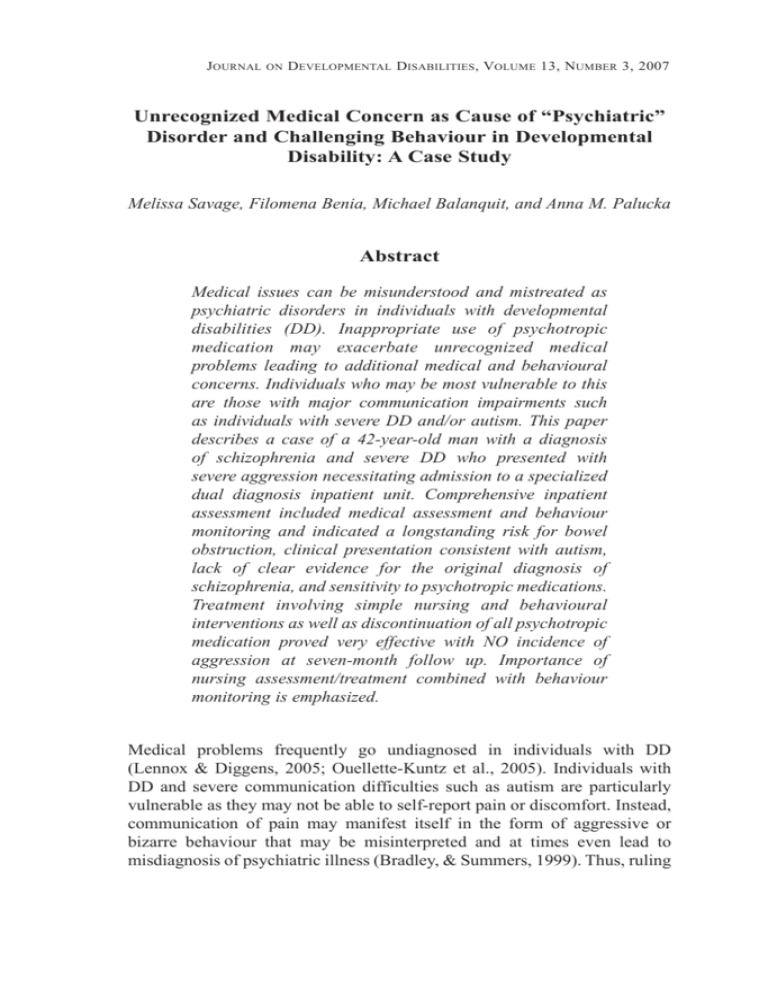
Journal on Developmental Disabilities, Volume 13, Number 3, 2007 Unrecognized Medical Concern as Cause of “Psychiatric” Disorder and Challenging Behaviour in Developmental Disability: A Case Study Melissa Savage, Filomena Benia, Michael Balanquit, and Anna M. Palucka Abstract Medical issues can be misunderstood and mistreated as psychiatric disorders in individuals with developmental disabilities (DD). Inappropriate use of psychotropic medication may exacerbate unrecognized medical problems leading to additional medical and behavioural concerns. Individuals who may be most vulnerable to this are those with major communication impairments such as individuals with severe DD and/or autism. This paper describes a case of a 42-year-old man with a diagnosis of schizophrenia and severe DD who presented with severe aggression necessitating admission to a specialized dual diagnosis inpatient unit. Comprehensive inpatient assessment included medical assessment and behaviour monitoring and indicated a longstanding risk for bowel obstruction, clinical presentation consistent with autism, lack of clear evidence for the original diagnosis of schizophrenia, and sensitivity to psychotropic medications. Treatment involving simple nursing and behavioural interventions as well as discontinuation of all psychotropic medication proved very effective with NO incidence of aggression at seven-month follow up. Importance of nursing assessment/treatment combined with behaviour monitoring is emphasized. Medical problems frequently go undiagnosed in individuals with DD (Lennox & Diggens, 2005; Ouellette-Kuntz et al., 2005). Individuals with DD and severe communication difficulties such as autism are particularly vulnerable as they may not be able to self-report pain or discomfort. Instead, communication of pain may manifest itself in the form of aggressive or bizarre behaviour that may be misinterpreted and at times even lead to misdiagnosis of psychiatric illness (Bradley, & Summers, 1999). Thus, ruling 206 Savage et al . out medical issues is a critical part of psychiatric assessment of individuals with DD (Bradley, & Summers 1999; Charlot, 2005). Failure to do so can result in inappropriate and sometimes harmful treatment. The case described below is an example of such a misdiagnosis. Background Information Mr. X is a 42-year-old man who emigrated from Europe to Canada at age 10. At age 11 he was diagnosed with moderate intellectual disability and at age 20 he received diagnosis of undifferentiated schizophrenia. Until age 35 he resided with his mother who herself had cognitive limitations and limited English skills. He then moved to a group home of a community agency where he has remained. Mr. X has severe limitations with communication, self-care and life skills, as well as a history of inappropriate behaviours (running away, disrobing and masturbation in public) and physical and environmental aggression. Reason for Referral A consulting community psychiatrist referred Mr. X for inpatient admission to a specialized dual diagnosis program because of severe aggression that became unmanageable in the community residence and threatened his group home placement. In the 12-month period preceding inpatient admission, dramatic increase in the severity, intensity, frequency and unpredictability of aggression as well as general agitation were observed. Support staff reported frequent yelling, swearing, pulling at or stripping off his clothes, “threatening” postures (i.e., hands raised above his head), pacing, banging holes in walls, smashing windows, pulling staffs’ hair, and punching or pinning staff to floor which resulted in injuries. Behavioural strategies and pharmacological interventions proved ineffective. Psychiatric Information Mr. X had 5 prior brief (1-3 months) inpatient psychiatric admissions due to indecent public exposure (disrobing and masturbating) and aggression (attempting to strangle his mother and destroying property). His last hospitalization was 2 years previous to the referral. During each hospitalization he received consistent diagnosis of moderate to severe DD. The historical diagnosis of schizophrenia, however, was often queried Unrecognized Medical Concern: A Case Study 207 because of lack of clear psychotic symptoms, besides talking and laughing out of context. Despite the fact that during each hospitalization, symptoms of schizophrenia were not evident, the clinical impression with varying degree of certainty was still that of schizophrenia and he was always prescribed antipsychotic medication at discharge. Medical Concerns Review of past hospital records indicated longstanding history of irregular bowel movements and complaints of abdominal/stomach pain and nausea. Reports from community staff indicated infrequent bladder and bowel movements (e.g., no voids in a 6-hour period and no bowel movement for 4 consecutive days). Due to the severity of aggression (during his last visit to his family doctor he hit the technician while attempting to take blood), these factors along with other possible medical concerns (vision and dental) could not be assessed. At the time of admission to the inpatient dual diagnosis program, Mr. X had not been medically assessed for 2 years. Dual diagnosis staff raised concerns about side effects of psychotropic medication on urinary retention and constipation because of multiple and frequent medication changes in the eight-month period preceding the admission. Medications were: Zoloft, Zyprexa, Diazepam, Novo-Nizatidine, Clonazepam, Perphenazine, Docusate and Risperidal. Medications At Admission Upon admission to the inpatient unit, Mr. X’s medications prescribed by a community psychiatrist included the following psychotropic medications: Chlorpromazine 450 mg, Kermadrin 2.5 mg bid, Lorazepam 1 mg PRN, and Diazepam 10 mg PRN for medical appointments. In addition, he received 10 mg of Lipitor for cholesterol prescribed by his general practitioner. Results of Comprehensive Inpatient Assessment During his inpatient admission Mr. X underwent an interdisciplinary assessment to clarify his psychiatric diagnosis, and medical and behavioural concerns. Ten days following admission, nursing staff began to observe increased agitation and he began to receive medication daily for this agitation. Results from monitored urinations and bowel movements showed that during this time his urination was infrequent and he experienced 4 consecutive days of diarrhea followed by 4 consecutive days of constipation. At both of these 208 Savage et al . time periods, he was observed to frequently swear, pace and strip/pull at his clothes throughout the day. His interaction with others decreased such that he became reclusive to his bedroom and the washroom. He frequently would request to use the washroom and would attempt to urinate and/or have a bowel movement (i.e., he would pull his pants down, sit on the toilet and make moaning/grunting sounds). When he was not experiencing gastrointestinal distress, his agitation would temporarily cease. Functional analysis of behaviour indicated that his medical status, specifically his difficulties with urination and elimination, was the precipitant to his agitation. Results of psychiatric assessment indicated presentation that was consistent with that of autistic spectrum disorder with moderate-severe intellectual disability and severe communication impairment. There was no evidence of psychotic symptoms and consequently the diagnosis of schizophrenia was removed. Intervention Procedures and Results The necessity of psychotropic medications was questioned, given the lack of evidence of psychotic symptoms and the severity of side effects including problems with elimination. All scheduled psychotropic medications were discontinued with positive results( i.e., there was no appearance of psychotic symptoms). Mr. X’s urinary output and bowel movements were closely monitored, Metamucil was introduced and a toileting routine was established. Behavioural supports consisted of simple communication and verbal de-escalation strategies and ensuring frequent interactions with staff. The combination of the above intervention strategies was highly effective; urinary output and bowel movements quickly became regular and there was no agitation at time of discharge. Medications at Discharge Mr. X was discharged without any regular psychotropic medication. Lorazepam 2mg was prescribed on a PRN basis (i.e., as needed for agitation). His medication for cholesterol (Lipitor 10 mg) remained the same, and the only addition was Metamucil to regulate bowel movements. Maintenance and Generalization In order to foster Mr. X’s achieved behavioural stability, transition from hospital back to the community was gradual and included inpatient staff providing community support staff with education and training. This Unrecognized Medical Concern: A Case Study 209 involved offering an opportunity for the group home staff to directly observe inpatient nursing staff and behaviour therapist’s approach to patient care both in hospital and at his community day program. Modeled interactions highlighted effective behavioural and nursing interventions and facilitated increased comfort levels when interacting with Mr. X. This helped to alleviate community staff’s anxiety caused by his previous aggressive behaviour. Upon discharge, a personal support/crisis plan was developed that emphasized the importance of consistent implementation of toileting routine, monitoring of his daily bowel movements and urinations, and maintenance of his current medications (i.e., no psychotropic medication) as these had proven to be effective proactive strategies that prevented the onset of agitation which had in the past led to aggression. Follow-Up There has been no incidence of aggression in the seven months following Mr. X’s discharge from the dual diagnosis inpatient program. A community behaviour therapist reports that Mr. X’s bladder and bowel movements continue to be regular and his medications have not been changed. Concluding Thoughts Medical issues can be misunderstood and mistreated as psychiatric disorders in individuals with developmental disability. This case highlights increased vulnerability of those with major communication impairments associated with severe developmental disability and autism that inhibit their ability to self-report. Awareness of this emphasizes the importance of an integrative biopsychosocial assessment and treatment approach (Summers, Stavrakaki, Griffiths, & Cheetham, 2002). In the reported case, results of comprehensive assessment indicated that agitated and aggressive behaviour was a symptom of medical complications (i.e., urinary retention and constipation) that may have been related to or exacerbated by psychotropic medications, which were prescribed to manage this very behaviour. Discontinuation of the medications and introduction of simple nursing and behavioural interventions proved to be effective and sufficient. This underscores the important role community nursing can play in monitoring health status of individuals with developmental disabilities and psychiatric or behaviour concerns and educating caregivers to recognize medical problems in those under their care (Summers, 2005). 210 Savage et al . References Bradley, E. A., & Summers, J. (1999). Developmental disability and behavioural, emotional, and psychiatric disturbances. In I. Brown & M. Percy (Eds.), Developmental disabilities in Ontario (pp.409-428). Toronto, Canada: Front Porch Publishing. Charlot, L. (2005). Some lessons learned about people with autism spectrum disorders. The NADD Bulletin, 8, 38-42. Lennox, N., & Diggens, J. (2005). Management guidelines: Developmental disability (Version 2). Victoria, Australia: Therapeutic Guidelines Limited. Lunsky, Y., Bradley, E., Durbin, J., Koegl, C., Canrinus, M., & Goering, P. (In press). The clinical profile service needs of adults with a dual diagnosis in psychiatric hospitals. Toronto: Psychiatric Services, Centre for Addiction and Mental Health. Ouellette-Kuntz, H., Garcin, N., Lewis, M. E. S., Minnes, P., Martin, C., & Holden, J. J. A. (2005). Addressing health disparities through promoting equity for individuals with intellectual disability (Commentary). Canadian Journal of Public Health, 96 (Suppl. 2), S8-S22. Summers, J., Adamson, J., Bradley, E. A., Boyd, K., Collins, S., Levinson, A., & Morgan, J. (2005). The need for more community nursing for adults with intellectual disabilities and mental health problems. Canadian Journal of Psychiatry, 50, 187. Summers, J., Stavrakaki, C., Griffiths, D. M., & Cheetham, T. (2002). Comprehensive screening and assessment. In D. M. Griffiths, C. Stavrakaki, & J. Summers (Eds.), Dual diagnosis: An introduction to the mental health needs of persons with developmental disabilities (pp. 151-192). Canada: Habilitative Mental Health Resource Network. Correspondence Melissa Savage Centre for Addiction and Mental Health Peel Dual Diagnosis Service 30 Eglinton Avenue West, Suite 801 Mississauga, Ontario Canada L5R 3E7 melissa_savage@camh.net

